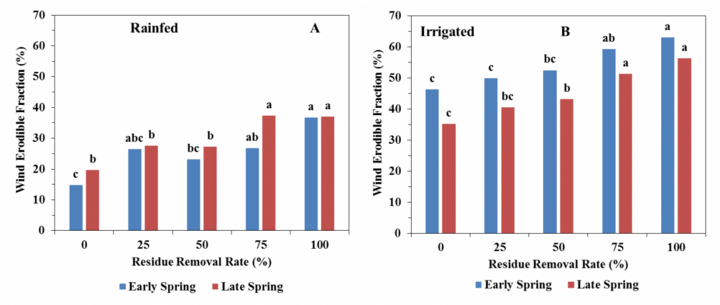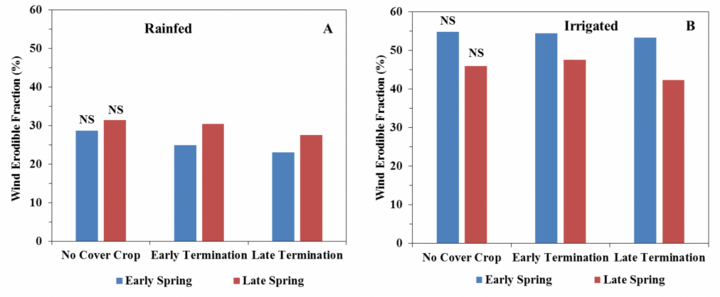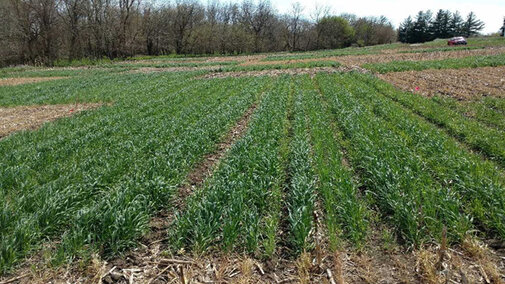Amber Blue, Student at Alabama A&M University and 2017 University of Nebraska-Lincoln Integrated Agronomic Systems Intern
Sabrina Ruis, Post-Doctoral Research Associate, Department of Agronomy and Horticulture
Humberto Blanco, Soils Specialist, Department of Agronomy and Horticulture
Paul Jasa, Nebraska Extension Engineer
Richard Ferguson, Professor and Interim Department Head, Department of Agronomy and Horticulture, and
Glen Slater, Research Analyst, South Cental Ag Lab
Wind Erosion Extent
Farming activities that remove high rates of crop residue can accelerate soil erosion from wind. This erosion, which removes topsoil, reduces soil organic matter, and degrades soil structure, can lead to reduced soil productivity and increased production costs. Wind erosion is particularly problematic in water-limited regions such as the central Great Plains. In semiarid and open relatively flat regions like parts of Nebraska, wind erosion can range from 2.1 to 7.9 tons per acre annually (Hansen et al., 2012).
Removing residue through baling is a common practice to meet demands for animal feed and bedding, and biofuel production. Removing crop residues leaves the soil vulnerable to wind erosion forces. These are most prevalent in spring after the soil has gone through freeze-thaw cycles that can break up soil aggregates. Previous studies in Nebraska and the region have found that changes in crop residue cover, particularly when residue removal is more than 50%, can increase wind erosion potential (Ruis et al., 2018; Blanco-Canqui et al., 2017; Blanco-Canqui et al., 2016; Osborne et al., 2014).
Wind Erosion and High Rates of Crop Residue Removal
We measured wind erosion potential using an ongoing three-year study being conducted at both a rainfed and an irrigated location in Nebraska. The rainfed site was at the university’s Rogers Memorial Farm near Lincoln on an Aksarben silty clay loam with less than a 3% slope. The irrigated site was at the South Central Agricultural Lab near Clay Center on a Hastings silt loam with less than a 1% slope.
Five rates of corn residue removal were imposed (0%, 25%, 50%, 75%, and 100%) after corn harvest in the fall; a cereal rye cover crop was planted after harvest (Figure 1). To assess wind erosion potential, soil samples were collected with a flat base shovel in early spring and again in late spring before corn planting. The samples were air-dried and sieved in a sieve shaker to determine the wind erodible fraction of the soil. This is the portion of the soil with soil particles and aggregates less than 0.84 mm in diameter, the particle size most susceptible to wind erosion. The results showed that complete residue removal (100%) increased the wind erodible fraction by 17% to 22% at both sites compared to no removal (Figure 2). A more typical residue removal rate of about 50% did not affect the wind erodible fraction at either site.

A Potential Solution to Reduce Wind Erosion After High Rates of Residue Removal
Adding cover crops to corn production systems may mitigate the negative effects of residue removal because the added above- and belowground biomass (i.e., soil cover) can reduce soil erodibility. In the study described here, a rye cover crop was terminated at two times: early (about 30 days before planting corn) or late (at corn planting). Soil was sampled in early and late spring, which coincided with early and late termination of the cover crops. At the rainfed site, biomass yield from the early-terminated cover crop was 0.47 tons/acre, and from the late-terminated cover crop, it was 1.35 tons/acre.

At the irrigated site, biomass yield from the early-terminated cover crop was 0.46 tons/acre and from the late-terminated cover crop, it was 1.82 tons/acre. Despite having roughly three to four times greater rye biomass yield with the late-terminated cover crop, cover crops did not significantly reduce wind erosion potential at either site; although there were trends for lower wind erosion potential with late-terminated cover crop (Figure 3).

Even though cover crops were not shown to reduce the wind erodible fraction in this study, they can still reduce wind erosion potential by providing protective surface cover. Between fall and spring, a large portion of crop residues will decay or blow away, leaving the soil unprotected. Having a cover crop in place provides some soil cover and protection from erosion. Figure 4 describes the relationship between wind erosion potential and soil cover by crop residues and cover crops in early spring at the irrigated site. Similar relationships were observed in late spring at the irrigated site and both early and late spring at the rainfed site. These relationships show that the wind erodible fraction decreases as soil cover increases.
Conclusion
Corn residue removal at high rates (more than 50%) can increase the wind erodible fraction of the soil. Adding a rye cover crop did not appear to reduce the wind erosion potential at the two sites in Nebraska. However, using a cover crop could still reduce wind erosion by covering the soil surface from fall through spring when freezing and thawing processes can degrade soil aggregates. Cover crops can be critical, particularly in spring when winds are strong and residue cover from the primary crop is limited.
References
Blanco-Canqui, H., and C. Wortmann. 2017. Crop residue removal and soil erosion by wind. Journal of Soil and Water Conservation. 72:97A-104A.
Blanco-Canqui H., J. Tatarko, A.L. Stalker, T.M. Shaver, and S.J. van Donk. 2016. Impacts of corn residue grazing and baling on wind erosion potential in a semiarid environment. Soil Science Society of America Journal. 80:1027–1037.
Hansen, N.C., B.L. Allen, R.L. Baumhardt, and D.J. Lyon. 2012. Research achievements and adoption of no-till, dryland cropping in the semi-arid U.S. Great Plains. Field Crops Research132:196-203.
Osborne, S.L., J.M.F. Johnson, V.L. Jin, A.L. Hammerbeck, G.E. Varvel, and T.E. Schumacher. 2014. The impact of corn residue removal on soil aggregates and particulate organic matter. BioEnergy Research. 7:559-567.
Ruis, S.J., H. Blanco-Canqui, C. Burr, B. Olson, M. Reiman, D. Rudnick, R. Drijber, and T. Shaver. 2018. Corn residue baling and grazing impacts on soil carbon stocks and other properties on a haplustoll. Soil Science Society of America Journal. in press

About the Lead Author
Amber Blue is one of seven undergraduate students completing an Integrated Agronomic Systems Fellowship at the University of Nebraska-Lincoln in summer 2017.
A native of Las Vegas, Nevada, with a passion for soil science and extension education, Blue graduated in December 2017 from the Alabama A&M University (AAMU). She received her B.S. in Environmental Science (Plant and Soil science) with a minor in Geographic Information Systems. Currently Ms. Blue is the program assistant for the Small Farms Research Center in the AAMU College of Agricultural, Life & Natural Sciences. She plans to attend graduate school in the fall for extension outreach/education with international application.
Support
Support for this project was provided by the USDA NIFA Agriculture and Food Research Initiative: Education and Literacy Initiative–Undergraduate Experiential Learning Fellowship Program and the University of Nebraska-Lincoln Department of Agronomy and Horticulture.

